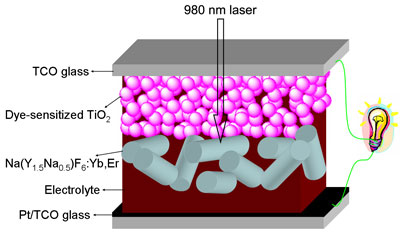| Posted: Dec 11, 2009 | |
Photovoltaic cells to power biological nanorobots inside the body |
|
| (Nanowerk Spotlight) As the fields of bionanotechnologies develop, it will become possible one day to use biological nanodevices such as nanorobots for in situ and real-time in vivo diagnosis and therapeutic intervention of specific targets. A prerequisite for designing and constructing wireless biological nanorobots is the availability of an electrical source which can be made continuously available in the operational biological environment (i.e. the human body). | |
| Several possible sources – temperature displacement, kinetic energy derived from blood flow, and chemical energy released from biological motors inside the body – have been designed to provide the electrical sources that can reliably operate in body (read: "Nanopiezotronics – a pathway to self-powering nanodevices"). | |
| Recently, the conversion of mechanical energy to electricity on the nanoscale has been successfully demonstrated by using acoustically actuated nanogenerators based on piezoelectric zinc oxide nanowires by Zhong Lin Wang's group (see: "Nanoscale power plants"). These nanogenerators can be used to drive many kinds of nanodevices, but their output powers needs to be further improved to meet the power requirement (at least 1 µW) of biological nanorobots. | |
| Light-harvesting by photovoltaic cells has been conclusively demonstrated as an efficient way to create electricity, and many kinds of solar cells have been developed. Unfortunately, these traditional solar cells cannot be used directly to power in vivo nanodevices because they mainly absorb visible and/or ultraviolet light – which is difficult to penetrate into biological tissues. On the other hand, light that can easily penetrate body tissue such as near infrared light in the wavelength range from 700 to 1000nm cannot be efficiently absorbed by conventional solar cells. | |
| Researchers in China and Germany have now reported, for the first time, the construction of a 980-nm laser-driven photovoltaic cell that can provide a sufficient power output even when covered by thick biological tissue layers because of the high transparency of biological tissues to 980-nm light. They use rare earth upconverting nanophosphors to absorb 980 nm laser light and then emit visible luminescence which can subsequently excite traditional solar cells to produce electricity. | |
| "It is well known that near-infrared light in the wavelength range from 700 to 1000nm is absorbed less by biological tissues; the typical penetration depth of 980-nm light can be several centimeters in biological tissue," Zhigang Chen explains to Nanowerk. "Light-absorbing materials developed for solar cells, such as silicon and dyes, cannot, however, efficiently absorb near-infrared light such as 980-nm laser light. In contrast, it can be efficiently absorbed by some rare-earth phosphors, after which they exhibit up-converted luminescence in the visible range." | |
 |
|
| Schematic illustration of the photovoltaic cell containing the Na(Y1.5Na0.5)F6:Yb,Er film. (source: ) | |
| In a recent issue of Advanced Functional Materials ("980-nm Laser-Driven Photovoltaic Cells Based on Rare-Earth Up-Converting Phosphors for Biomedical Applications), Chen, a researcher at the State Key Laboratory for Modification of Chemical Fibers and Polymer Materials at Donghua University in Shanghai, together with his colleagues and collaborators from Max Planck Institute for Colloids and Interfaces in Potsdam, Germany, report on the first preparation of 980 nm laser driven photovoltaic cells (980LD-PVCs) by introducing the film of rare earth up-converting nanophosphors in conventional dye-sensitized solar cells. | |
| According to Chen, the 980LD-PVCs can provide a sufficient power output even under the coating of thick biological tissue layers due to the high transparency of biological tissues to 980 nm light. | |
| In their work, the research team determined that, under the irradiation of a 980-nm laser with a power of 1W, the visible up-converting luminescence of rare-earth nanophosphors can be efficiently absorbed by the dyes in 980LD-PVCs so that they exhibit a maximal output power of 0.47 mW. | |
| In particular, after being covered with 1 to 6 layers of pig intestines (thickness: ca. 1mm per layer) as a model of biological tissues, 980LD-PVCs still possess a maximal output power of between 0.28 and 0.02 mW, which is efficient enough to drive many kinds of biodevices. | |
| This research opens up the possibility of developing novel electrical sources for wireless biological nanorobots and many other biodevices to operate inside the body. | |
| There are still some challenges to overcome, in particular the requirement that all components of the power device are biocompatible. Although the present 980LD-PVCs can provide a sufficient power output under the coating of thick biological tissue layers, according to Chen there are still three problems: 1) some component in 980LD-PVCs are biologically non-compatible and should be replaced; 2) the overall 980-nm-laser-to-electrical energy conversion efficiency is low due to the low near-infrared-to-visible upconversion efficiency, so the electrode based on rare earth upconverting nanophosphors should be further optimized; 3) 980LD-PVCs should be further miniaturized to fit the requirements of in vivo applications. | |
 By
Michael
Berger
– Michael is author of three books by the Royal Society of Chemistry:
Nano-Society: Pushing the Boundaries of Technology,
Nanotechnology: The Future is Tiny, and
Nanoengineering: The Skills and Tools Making Technology Invisible
Copyright ©
Nanowerk LLC
By
Michael
Berger
– Michael is author of three books by the Royal Society of Chemistry:
Nano-Society: Pushing the Boundaries of Technology,
Nanotechnology: The Future is Tiny, and
Nanoengineering: The Skills and Tools Making Technology Invisible
Copyright ©
Nanowerk LLC
|
|
|
Become a Spotlight guest author! Join our large and growing group of guest contributors. Have you just published a scientific paper or have other exciting developments to share with the nanotechnology community? Here is how to publish on nanowerk.com. |
|
